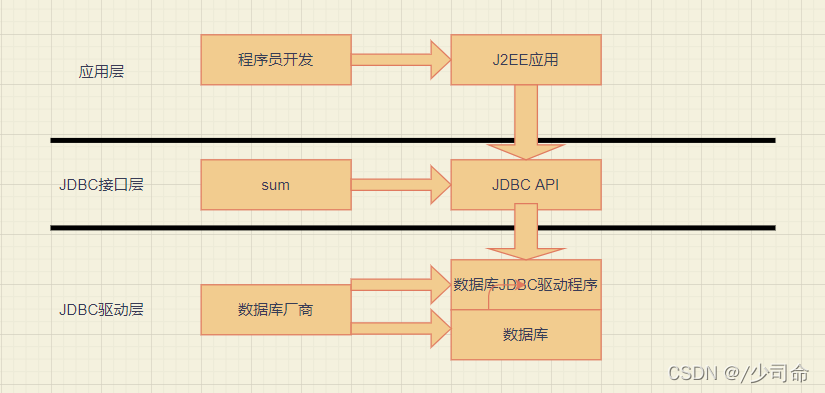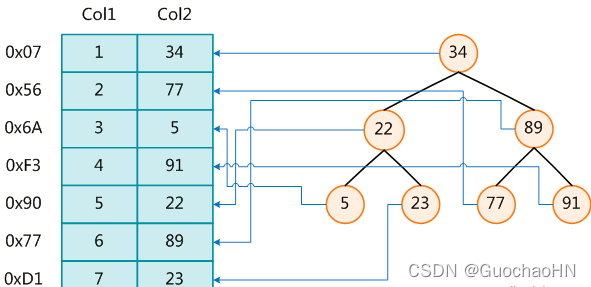一、MySQL自带的压力测试工具 Mysqlslap
mysqlslap是mysql自带的基准测试工具,该工具查询数据,语法简单,灵活容易使用.该工具可以模拟多个客户端同时并发的向服务器发出查询更新,给出了性能测试数据而且提供了多种引擎的性能比较。mysqlslap为mysql性能优化前后提供了直观的验证依据,系统运维和DBA人员应该掌握一些常见的压力测试工具,才能准确的掌握线上数据库支撑的用户流量上限及其抗压性等问题。
1、更改其默认的最大连接数
在对MySQL进行压力测试之前,需要更改其默认的最大连接数,如下:
[root@mysql~]#vim/etc/my.cnf ................ [mysqld] max_connections=1024 [root@mysql~]#systemctlrestartmysqld ` 查看最大连接数 `mysql>showvariableslike'max_connections'; +-----------------+-------+ |Variable_name|Value| +-----------------+-------+ |max_connections|1024| +-----------------+--------+ 1rowinset(0.00sec)
进行压力测试:
[root@mysql~]#mysqlslap--defaults-file=/etc/my.cnf--concurrency=100,200--iterations=1--number-int-cols=20--number-char-cols=30 --auto-generate-sql--auto-generate-sql-add-autoincrement--auto-generate-sql-load-type=mixed--engine=myisam,innodb--number-of-queries=2000-uroot-p123--verbose
上述命令测试说明:模拟测试两次读写并发,第一次100,第二次200,自动生成SQL脚本,测试表包含20个init字段,30个char字段,每次执行2000查询请求。测试引擎分别是myisam,innodb。(上述选项中有很多都是默认值,可以省略,如果想要了解各个选项的解释,可以使用mysqlslap --help进行查询)。
测试结果说明:
- Myisam第一次100客户端同时发起增查用0.557/s,第二次200客户端同时发起增查用0.522/s
- Innodb第一次100客户端同时发起增查用0.256/s,第二次200客户端同时发起增查用0.303/s
可以根据实际需求,一点点的加大并发数量进行压力测试。
二、使用第三方sysbench工具进行压力测试
1、安装sysbench工具
[root@mysql~]#yum-yinstallepel-release#安装第三方epel源 [root@mysql~]#yum-yinstallsysbench#安装sysbench工具 [root@mysql~]#sysbench--version#确定工具已安装 sysbench1.0.17
sysbench可以进行以下测试:
- CPU 运算性能测试
- 磁盘 IO 性能测试
- 调度程序性能测试
- 内存分配及传输速度测试
- POSIX 线程性能测试
数据库性能测试(OLTP 基准测试,需要通过 /usr/share/sysbench/ 目录中的 Lua 脚本执行,例如 oltp_read_only.lua 脚本执行只读测试)。
sysbench 还可以通过运行命令时指定自己的 Lua 脚本来自定义测试。
2、查看sysbench工具的帮助选项
[root@mysql~]#sysbench--help
Usage:
sysbench[options]...[testname][command]
Commandsimplementedbymosttests:prepareruncleanuphelp#可用的命令,四个
Generaloptions:#通用选项
--threads=N要使用的线程数,默认1个[1]
--events=N最大允许的事件个数[0]
--time=N最大的总执行时间,以秒为单位[10]
--forced-shutdown=STRING在--time时间限制到达后,强制关闭之前等待的秒数,默认“off”禁用(numberofsecondstowaitafterthe--timelimitbeforeforcingshutdown,or'off'todisable)[off]
--thread-stack-size=SIZE每个线程的堆栈大小[64K]
--rate=N 平均传输速率。0则无限制[0]
--report-interval=N以秒为单位定期报告具有指定间隔的中间统计信息0禁用中间报告[0]
--report-checkpoints=[LIST,...]转储完整的统计信息并在指定的时间点重置所有计数器。参数是一个逗号分隔的值列表,表示从测试开始经过这个时间量时必须执行报告检查点(以秒为单位)。报告检查点默认关闭。[]
--debug[=on|off]打印更多debug信息[off]
--validate[=on|off]尽可能执行验证检查[off]
--help[=on|off]显示帮助信息并退出[off]
--version[=on|off]显示版本信息并退出[off]
--config-file=FILENAME包含命令行选项的文件
--tx-rate=N废弃,改用--rate[0]
--max-requests=N废弃,改用--events[0]
--max-time=N废弃,改用--time[0]
--num-threads=N废弃,改用--threads[1]
Pseudo-RandomNumbersGeneratoroptions:#伪随机数发生器选项
--rand-type=STRINGrandomnumbersdistribution{uniform,gaussian,special,pareto}[special]
--rand-spec-iter=Nnumberofiterationsusedfornumbersgeneration[12]
--rand-spec-pct=Npercentageofvaluestobetreatedas'special'(forspecialdistribution)[1]
--rand-spec-res=Npercentageof'special'valuestouse(forspecialdistribution)[75]
--rand-seed=Nseedforrandomnumbergenerator.When0,thecurrenttimeisusedasaRNGseed.[0]
--rand-pareto-h=Nparameterhforparetodistribution[0.2]
Logoptions:#日志选项
--verbosity=Nverbositylevel{5-debug,0-onlycriticalmessages}[3]
--percentile=Npercentiletocalculateinlatencystatistics(1-100).Usethespecialvalueof0todisablepercentilecalculations[95]
--histogram[=on|off]printlatencyhistograminreport[off]
Generaldatabaseoptions:#通用的数据库选项
--db-driver=STRING指定要使用的数据库驱动程序('help'togetlistofavailabledrivers)
--db-ps-mode=STRINGpreparedstatementsusagemode{auto,disable}[auto]
--db-debug[=on|off]printdatabase-specificdebuginformation[off]
Compiled-indatabasedrivers:#內建的数据库驱动程序,默认支持MySQL和PostgreSQL
mysql-MySQLdriver
pgsql-PostgreSQLdriver
mysqloptions:#MySQL数据库专用选项
--mysql-host=[LIST,...]MySQLserverhost[localhost]
--mysql-port=[LIST,...]MySQLserverport[3306]
--mysql-socket=[LIST,...]MySQLsocket
--mysql-user=STRINGMySQLuser[sbtest]
--mysql-password=STRINGMySQLpassword[]
--mysql-db=STRINGMySQLdatabasename[sbtest]
--mysql-ssl[=on|off]useSSLconnections,ifavailableintheclientlibrary[off]
--mysql-ssl-cipher=STRINGusespecificcipherforSSLconnections[]
--mysql-compression[=on|off]usecompression,ifavailableintheclientlibrary[off]
--mysql-debug[=on|off]traceallclientlibrarycalls[off]
--mysql-ignore-errors=[LIST,...]listoferrorstoignore,or"all"[1213,1020,1205]
--mysql-dry-run[=on|off]Dryrun,pretendthatallMySQLclientAPIcallsaresuccessfulwithoutexecutingthem[off]
pgsqloptions:#PostgreSQL数据库专用选项
--pgsql-host=STRINGPostgreSQLserverhost[localhost]
--pgsql-port=NPostgreSQLserverport[5432]
--pgsql-user=STRINGPostgreSQLuser[sbtest]
--pgsql-password=STRINGPostgreSQLpassword[]
--pgsql-db=STRINGPostgreSQLdatabasename[sbtest]
Compiled-intests:#內建测试类型
fileio-FileI/Otest
cpu-CPUperformancetest
memory-Memoryfunctionsspeedtest
threads-Threadssubsystemperformancetest
mutex-Mutexperformancetest
See'sysbench<testname>help'foralistofoptionsforeachtest.
3、sysbench测试MySQL数据库性能
1)准备测试数据
#查看sysbench自带的lua脚本使用方法 [root@mysql~]#sysbench/usr/share/sysbench/oltp_common.luahelp #必须创建sbtest库,sbtest是sysbench默认使用的库名 [root@mysql~]#mysqladmin-uroot-p123createsbtest; #然后,准备测试所用的表,这些测试表放在测试库sbtest中。这里使用的lua脚本为/usr/share/sysbench/oltp_common.lua。 [root@mysql~]#sysbench--mysql-host=127.0.0.1 --mysql-port=3306 --mysql-user=root --mysql-password=123 /usr/share/sysbench/oltp_common.lua --tables=10 --table_size=100000 prepare #其中--tables=10表示创建10个测试表, #--table_size=100000表示每个表中插入10W行数据, #prepare表示这是准备数的过程。
2)确认测试数据以存在
[root@mysql~]#mysql-uroot-p123sbtest;#登录到sbtest库 mysql>showtables;#查看相应的表 +------------------+ |Tables_in_sbtest| +------------------+ |sbtest1| |sbtest10| |sbtest2| |sbtest3| |sbtest4| |sbtest5| |sbtest6| |sbtest7| |sbtest8| |sbtest9| +------------------+ 10rowsinset(0.00sec)
mysql>selectcount(*)fromsbtest1;#随机选择一个表,确认其有100000条数据 +----------+ |count(*)| +----------+ |100000| +----------+ 1rowinset(0.01sec)
3)数据库测试和结果分析
稍微修改下之前准备数据的语句,就可以拿来测试了。需要注意的是,之前使用的lua脚本为oltp_common.lua,它是一个通用脚本,是被其它lua脚本调用的,它不能直接拿来测试。
所以,我这里用oltp_read_write.lua脚本来做读、写测试。还有很多其它类型的测试,比如只读测试、只写测试、删除测试、大批量插入测试等等。可找到对应的lua脚本进行调用即可。
#执行测试命令如下: [root@mysql~]#sysbench--threads=4 --time=20 --report-interval=5 --mysql-host=127.0.0.1 --mysql-port=3306 --mysql-user=root --mysql-password=123 /usr/share/sysbench/oltp_read_write.lua --tables=10 --table_size=100000 run
上述命令返回的结果如下:
[root@mysql~]#sysbench--threads=4--time=20--report-interval=5--mysql-host=127.0.0.1--mysql-port=3306--mysql-user=root--mysql-password=123/usr/share/sysbench/oltp_read_write.lua--tables=10--table_size=100000run sysbench1.0.17(usingsystemLuaJIT2.0.4) Runningthetestwithfollowingoptions: Numberofthreads:4 Reportintermediateresultsevery5second(s) Initializingrandomnumbergeneratorfromcurrenttime Initializingworkerthreads... Threadsstarted! #以下是每5秒返回一次的结果,统计的指标包括: #线程数、tps(每秒事务数)、qps(每秒查询数)、 #每秒的读/写/其它次数、延迟、每秒错误数、每秒重连次数 [5s]thds:4tps:1040.21qps:20815.65(r/w/o:14573.17/4161.25/2081.22)lat(ms,95%):7.17err/s:0.00reconn/s:0.00 [10s]thds:4tps:1083.34qps:21667.15(r/w/o:15165.93/4334.55/2166.68)lat(ms,95%):6.55err/s:0.00reconn/s:0.00 [15s]thds:4tps:1121.57qps:22429.09(r/w/o:15700.64/4485.30/2243.15)lat(ms,95%):6.55err/s:0.00reconn/s:0.00 [20s]thds:4tps:1141.69qps:22831.98(r/w/o:15982.65/4566.16/2283.18)lat(ms,95%):6.09err/s:0.00reconn/s:0.00 SQLstatistics: queriesperformed: read:307146#执行的读操作数量 write:87756#执行的写操作数量 other:43878#执行的其它操作数量 total:438780 transactions:21939(1096.57persec.)#执行事务的平均速率 queries:438780(21931.37persec.)#平均每秒能执行多少次查询 ignorederrors:0(0.00persec.) reconnects:0(0.00persec.) Generalstatistics: totaltime:20.0055s#总消耗时间 totalnumberofevents:21939#总请求数量(读、写、其它) Latency(ms): min:1.39 avg:3.64 max:192.05 95thpercentile:6.67#采样计算的平均延迟 sum:79964.26 Threadsfairness: events(avg/stddev):5484.7500/15.12 executiontime(avg/stddev):19.9911/0.00
4、cpu/io/内存等测试
sysbench内置的几个测试指标如下:
[root@mysql~]#sysbench--help ..........#省略部分内容 Compiled-intests: fileio-FileI/Otest cpu-CPUperformancetest memory-Memoryfunctionsspeedtest threads-Threadssubsystemperformancetest mutex-Mutexperformancetest
可以直接help输出测试方法,例如,fileio测试:
[root@mysql~]#sysbenchfileiohelp
sysbench1.0.17(usingsystemLuaJIT2.0.4)
fileiooptions:
--file-num=Nnumberoffilestocreate[128]
--file-block-size=NblocksizetouseinallIOoperations[16384]
--file-total-size=SIZEtotalsizeoffilestocreate[2G]
--file-test-mode=STRINGtestmode{seqwr,seqrewr,seqrd,rndrd,rndwr,rndrw}
--file-io-mode=STRINGfileoperationsmode{sync,async,mmap}[sync]
--file-async-backlog=Nnumberofasynchronousoperatonstoqueueperthread[128]
--file-extra-flags=[LIST,...]listofadditionalflagstousetoopenfiles{sync,dsync,direct}[]
--file-fsync-freq=Ndofsync()afterthisnumberofrequests(0-don'tusefsync())[100]
--file-fsync-all[=on|off]dofsync()aftereachwriteoperation[off]
--file-fsync-end[=on|off]dofsync()attheendoftest[on]
--file-fsync-mode=STRINGwhichmethodtouseforsynchronization{fsync,fdatasync}[fsync]
--file-merged-requests=NmergeatmostthisnumberofIOrequestsifpossible(0-don'tmerge)[0]
--file-rw-ratio=Nreads/writesratioforcombinedtest[1.5]
1)测试io性能
例如,创建5个文件,总共2G,每个文件大概400M。
[root@mysql~]#sysbenchfileio--file-num=5--file-total-size=2Gprepare [root@mysql~]#ll-lhtest* -rw-------1rootroot410MMay2616:05test_file.0 -rw-------1rootroot410MMay2616:05test_file.1 -rw-------1rootroot410MMay2616:05test_file.2 -rw-------1rootroot410MMay2616:05test_file.3 -rw-------1rootroot410MMay2616:05test_file.4
然后运行测试:
[root@mysql~]#sysbench--events=5000 --threads=16 fileio --file-num=5 --file-total-size=2G --file-test-mode=rndrw --file-fsync-freq=0 --file-block-size=16384 run
返回的结果如下:
Runningthetestwithfollowingoptions: Numberofthreads:16 Initializingrandomnumbergeneratorfromcurrenttime Extrafileopenflags:(none) 5files,409.6MiBeach 2GiBtotalfilesize Blocksize16KiB NumberofIOrequests:5000 Read/WriteratioforcombinedrandomIOtest:1.50 Callingfsync()attheendoftest,Enabled. UsingsynchronousI/Omode Doingrandomr/wtest Initializingworkerthreads... Threadsstarted! Fileoperations: reads/s:9899.03 writes/s:6621.38 fsyncs/s:264.33 Throughput:#吞吐量 read,MiB/s:154.66#表示读带宽 written,MiB/s:103.46#表示写的带宽 Generalstatistics: totaltime:0.3014s totalnumberofevents:5000 Latency(ms): min:0.00 avg:0.81 max:53.56 95thpercentile:4.10 sum:4030.48 Threadsfairness: events(avg/stddev):312.5000/27.64 executiontime(avg/stddev):0.2519/0.02
2)测试cpu性能
[root@mysql~]#sysbenchcpu--threads=40--events=10000--cpu-max-prime=20000run
压测时,还请小心谨慎!!!!
以上就是MySQL压力测试工具Mysqlslap的使用的详细内容,更多关于Mysqlslap的使用的资料请关注其它相关文章!





